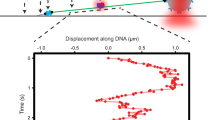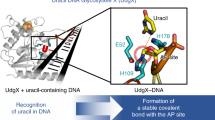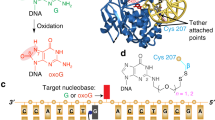Abstract
Threats to genomic integrity arising from DNA damage are mitigated by DNA glycosylases, which initiate the base excision repair pathway by locating and excising aberrant nucleobases1,2. How these enzymes find small modifications within the genome is a current area of intensive research. A hallmark of these and other DNA repair enzymes is their use of base flipping to sequester modified nucleotides from the DNA helix and into an active site pocket2,3,4,5. Consequently, base flipping is generally regarded as an essential aspect of lesion recognition and a necessary precursor to base excision. Here we present the first, to our knowledge, DNA glycosylase mechanism that does not require base flipping for either binding or catalysis. Using the DNA glycosylase AlkD from Bacillus cereus, we crystallographically monitored excision of an alkylpurine substrate as a function of time, and reconstructed the steps along the reaction coordinate through structures representing substrate, intermediate and product complexes. Instead of directly interacting with the damaged nucleobase, AlkD recognizes aberrant base pairs through interactions with the phosphoribose backbone, while the lesion remains stacked in the DNA duplex. Quantum mechanical calculations revealed that these contacts include catalytic charge–dipole and CH–π interactions that preferentially stabilize the transition state. We show in vitro and in vivo how this unique means of recognition and catalysis enables AlkD to repair large adducts formed by yatakemycin, a member of the duocarmycin family of antimicrobial natural products exploited in bacterial warfare and chemotherapeutic trials6,7. Bulky adducts of this or any type are not excised by DNA glycosylases that use a traditional base-flipping mechanism5. Hence, these findings represent a new model for DNA repair and provide insights into catalysis of base excision.
This is a preview of subscription content, access via your institution
Access options
Subscribe to this journal
Receive 51 print issues and online access
$199.00 per year
only $3.90 per issue
Buy this article
- Purchase on Springer Link
- Instant access to full article PDF
Prices may be subject to local taxes which are calculated during checkout




Similar content being viewed by others
Accession codes
References
Fromme, J. C. & Verdine, G. L. Base excision repair. Adv. Protein Chem. 69, 1–41 (2004)
Hitomi, K., Iwai, S. & Tainer, J. A. The intricate structural chemistry of base excision repair machinery: implications for DNA damage recognition, removal, and repair. DNA Repair (Amst.) 6, 410–428 (2007)
Slupphaug, G. et al. A nucleotide-flipping mechanism from the structure of human uracil-DNA glycosylase bound to DNA. Nature 384, 87–92 (1996)
Stivers, J. T. Site-specific DNA damage recognition by enzyme-induced base flipping. Prog. Nucleic Acid Res. Mol. Biol. 77, 37–65 (2004)
Brooks, S. C., Adhikary, S., Rubinson, E. H. & Eichman, B. F. Recent advances in the structural mechanisms of DNA glycosylases. Biochim. Biophys. Acta 1834, 247–271 (2013)
Igarashi, Y. et al. Yatakemycin, a novel antifungal antibiotic produced by Streptomyces sp. TP-A0356. J. Antibiot. (Tokyo) 56, 107–113 (2003)
Alberts, S. R., Suman, V. J., Pitot, H. C., Camoriano, J. K. & Rubin, J. Use of KW-2189, a DNA minor groove-binding agent, in patients with hepatocellular carcinoma: a north central cancer treatment group (NCCTG) phase II clinical trial. J. Gastrointest. Cancer 38, 10–14 (2007)
Friedberg, E. C. et al. DNA Repair and Mutagenesis 2nd edn (ASM Press, 2006)
Larson, K., Sahm, J., Shenkar, R. & Strauss, B. Methylation-induced blocks to in vitro DNA replication. Mutat. Res. 150, 77–84 (1985)
Plosky, B. S. et al. Eukaryotic Y-family polymerases bypass a 3-methyl-2′-deoxyadenosine analog in vitro and methyl methanesulfonate-induced DNA damage in vivo. Nucleic Acids Res. 36, 2152–2162 (2008)
Drohat, A. C. & Maiti, A. Mechanisms for enzymatic cleavage of the N-glycosidic bond in DNA. Org. Biomol. Chem. 12, 8367–8378 (2014)
Stivers, J. T. & Jiang, Y. L. A mechanistic perspective on the chemistry of DNA repair glycosylases. Chem. Rev. 103, 2729–2760 (2003)
Hendershot, J. M. & O’Brien, P. J. Critical role of DNA intercalation in enzyme-catalyzed nucleotide flipping. Nucleic Acids Res. 42, 12681–12690 (2014)
Alseth, I. et al. A new protein superfamily includes two novel 3-methyladenine DNA glycosylases from Bacillus cereus, AlkC and AlkD. Mol. Microbiol. 59, 1602–1609 (2006)
Rubinson, E. H., Metz, A. H., O’Quin, J. & Eichman, B. F. A new protein architecture for processing alkylation damaged DNA: the crystal structure of DNA glycosylase AlkD. J. Mol. Biol. 381, 13–23 (2008)
Rubinson, E. H., Gowda, A. S., Spratt, T. E., Gold, B. & Eichman, B. F. An unprecedented nucleic acid capture mechanism for excision of DNA damage. Nature 468, 406–411 (2010)
Dalhus, B. et al. Structural insight into repair of alkylated DNA by a new superfamily of DNA glycosylases comprising HEAT-like repeats. Nucleic Acids Res. 35, 2451–2459 (2007)
Mullins, E. A., Rubinson, E. H. & Eichman, B. F. The substrate binding interface of alkylpurine DNA glycosylase AlkD. DNA Repair (Amst.) 13, 50–54 (2014)
Mullins, E. A. et al. An HPLC-tandem mass spectrometry method for simultaneous detection of alkylated base excision repair products. Methods 64, 59–66 (2013)
Plevin, M. J., Bryce, D. L. & Boisbouvier, J. Direct detection of CH/π interactions in proteins. Nature Chem. 2, 466–471 (2010)
Yang, W. Poor base stacking at DNA lesions may initiate recognition by many repair proteins. DNA Repair (Amst.) 5, 654–666 (2006)
Brandl, M., Weiss, M. S., Jabs, A., Suhnel, J. & Hilgenfeld, R. C-H⋯π-interactions in proteins. J. Mol. Biol. 307, 357–377 (2001)
Wilson, K. A., Kellie, J. L. & Wetmore, S. D. DNA-protein π-interactions in nature: abundance, structure, composition and strength of contacts between aromatic amino acids and DNA nucleobases or deoxyribose sugar. Nucleic Acids Res. 42, 6726–6741 (2014)
Metz, A. H., Hollis, T. & Eichman, B. F. DNA damage recognition and repair by 3-methyladenine DNA glycosylase I (TAG). EMBO J. 26, 2411–2420 (2007)
Wilkinson, O. J. et al. Alkyltransferase-like protein (Atl1) distinguishes alkylated guanines for DNA repair using cation-π interactions. Proc. Natl Acad. Sci. USA 109, 18755–18760 (2012)
Tubbs, J. L. et al. Flipping of alkylated DNA damage bridges base and nucleotide excision repair. Nature 459, 808–813 (2009)
Xu, H. et al. Self-resistance to an antitumor antibiotic: a DNA glycosylase triggers the base-excision repair system in yatakemycin biosynthesis. Angew. Chem. Int. Ed. Engl. 51, 10532–10536 (2012)
Qi, Y. et al. Encounter and extrusion of an intrahelical lesion by a DNA repair enzyme. Nature 462, 762–766 (2009)
Imamura, K., Averill, A., Wallace, S. S. & Doublie, S. Structural characterization of viral ortholog of human DNA glycosylase NEIL1 bound to thymine glycol or 5-hydroxyuracil-containing DNA. J. Biol. Chem. 287, 4288–4298 (2012)
Adhikary, S. & Eichman, B. F. Analysis of substrate specificity of Schizosaccharomyces pombe Mag1 alkylpurine DNA glycosylase. EMBO Rep. 12, 1286–1292 (2011)
Chu, A. M., Fettinger, J. C. & David, S. S. Profiling base excision repair glycosylases with synthesized transition state analogs. Bioorg. Med. Chem. Lett. 21, 4969–4972 (2011)
O’Brien, P. J. & Ellenberger, T. Human alkyladenine DNA glycosylase uses acid-base catalysis for selective excision of damaged purines. Biochemistry 42, 12418–12429 (2003)
Bjelland, S., Birkeland, N. K., Benneche, T., Volden, G. & Seeberg, E. DNA glycosylase activities for thymine residues oxidized in the methyl group are functions of the AlkA enzyme in Escherichia coli. J. Biol. Chem. 269, 30489–30495 (1994)
Otwinowski, Z. & Minor, W. Processing of X-ray diffraction data. Methods Enzymol. 276, 307–326 (1997)
McCoy, A. J. et al. Phaser crystallographic software. J. Appl. Crystallogr. 40, 658–674 (2007)
Emsley, P., Lohkamp, B., Scott, W. & Cowtan, K. Features and development of Coot. Acta Crystallogr. D 66, 486–501 (2010)
Adams, P. D. et al. PHENIX: a comprehensive Python-based system for macromolecular structure solution. Acta Crystallogr. D 66, 213–221 (2010)
Davis, I. W. et al. MolProbity: all-atom contacts and structure validation for proteins and nucleic acids. Nucleic Acids Res. 35, W375–W383 (2007)
Ho, B. K. & Gruswitz, F. HOLLOW: generating accurate representations of channel and interior surfaces in molecular structures. BMC Struct. Biol. 8, 49 (2008)
Mike, L. A. et al. Two-component system cross-regulation integrates Bacillus anthracis response to heme and cell envelope stress. PLoS Pathog. 10, e1004044 (2014)
Sterne, M. Avirulent anthrax vaccine. Onderstepoort J. Vet. Sci. Anim. Ind. 21, 41–43 (1946)
Stauff, D. L. & Skaar, E. P. Bacillus anthracis HssRS signalling to HrtAB regulates haem resistance during infection. Mol. Microbiol. 72, 763–778 (2009)
Ho, J. & Coote, M. L. A universal approach for continuum solvent pKa calculations: are we there yet? Theor. Chem. Acc. 125, 3–21 (2010)
Kapinos, L. E., Operschall, B. P., Larsen, E. & Sigel, H. Understanding the acid–base properties of adenosine: the intrinsic basicities of N1, N3 and N7. Chemistry 17, 8156–8164 (2011)
Zhao, Y. & Truhlar, D. G. The M06 suite of density functionals for main group thermochemistry, thermochemical kinetics, noncovalent interactions, excited states, and transition elements: two new functionals and systematic testing of four M06-class functionals and 12 other functionals. Theor. Chem. Acc. 120, 215–241 (2008)
Marenich, A. V., Cramer, C. J. & Truhlar, D. G. Universal solvation model based on solute electron density and on a continuum model of the solvent defined by the bulk dielectric constant and atomic surface tensions. J. Phys. Chem. B 113, 6378–6396 (2009)
Dinner, A. R., Blackburn, G. M. & Karplus, M. Uracil-DNA glycosylase acts by substrate autocatalysis. Nature 413, 752–755 (2001)
Boys, S. F. & Bernardi, F. The calculation of small molecular interactions by the differences of separate total energies. Some procedures with reduced errors. Mol. Phys. 19, 553–566 (1970)
Shibasaki, K., Fujii, A., Mikami, N. & Tsuzuki, S. Magnitude of the CH/π interaction in the gas phase: experimental and theoretical determination of the accurate interaction energy in benzene-methane. J. Phys. Chem. A 110, 4397–4404 (2006)
Meot-Ner, M. & Deakyne, C. A. Unconventional ionic hydrogen-bonds. 1. CHδ+···X. Complexes of quaternary ions with n- and π-donors. J. Am. Chem. Soc. 107, 469–474 (1985)
Osborne, M. R. & Phillips, D. H. Preparation of a methylated DNA standard, and its stability on storage. Chem. Res. Toxicol. 13, 257–261 (2000)
Singh, U. C. & Kollman, P. A. An approach to computing electrostatic charges for molecules. J. Comput. Chem. 5, 129–145 (1984)
Besler, B. H., Merz, K. M. & Kollman, P. A. Atomic charges derived from semiempirical methods. J. Comput. Chem. 11, 431–439 (1990)
Ramstein, J. & Lavery, R. Energetic coupling between DNA bending and base pair opening. Proc. Natl Acad. Sci. USA 85, 7231–7235 (1988)
Adhikary, S., Cato, M. C., McGary, K. L., Rokas, A. & Eichman, B. F. Non-productive DNA damage binding by DNA glycosylase-like protein Mag2 from Schizosaccharomyces pombe. DNA Repair (Amst.) 12, 196–204 (2013)
Dalhus, B. et al. Sculpting of DNA at abasic sites by DNA glycosylase homolog Mag2. Structure 21, 154–166 (2013)
Acknowledgements
We thank C. Rizzo and T. Johnson Salyard for assistance with oligodeoxynucleotide synthesis and E. Skaar and L. Mike for assistance with genetic manipulation of B. anthracis. This work was funded by the National Science Foundation (MCB-1122098 and MCB-1517695 to B.F.E.) and the National Institutes of Health (R01ES019625 to B.F.E. and R01CA067985 to S.S.D.). Support for the Vanderbilt Robotic Crystallization Facility was also provided by the National Institutes of Health (S10RR026915). Use of the Advanced Photon Source, an Office of Science User Facility operated for the US Department of Energy Office of Science by Argonne National Laboratory, was supported by the US Department of Energy (DE-AC02-06CH11357). Use of LS-CAT Sector 21 was supported by the Michigan Economic Development Corporation and the Michigan Technology Tri-Corridor (085P1000817). E.A.M. and Z.D.P. were partially supported by the Vanderbilt Training Program in Environmental Toxicology (T32ES07028).
Author information
Authors and Affiliations
Contributions
E.A.M. and B.F.E. conceived the project; E.A.M., R.S., Z.D.P. and B.F.E. designed experiments; E.A.M. performed biochemical and structural experiments; R.S. performed cellular experiments; Z.D.P. performed computational experiments; P.K.Y., S.S.D. and Y.I. supplied reagents; E.A.M., R.S., Z.D.P. and B.F.E. analysed data and wrote the paper; all authors commented on the manuscript.
Corresponding author
Ethics declarations
Competing interests
The authors declare no competing financial interests.
Extended data figures and tables
Extended Data Figure 1 Remodelled DNA structures.
DNA binding by AlkD bends the helical axis by 30° and widens the minor groove by 4 Å. Remodelling of this type reduces the energetic barrier to base pair opening but does not force base flipping54,55,56. In the AlkD–3d3mA-DNA complex, this distortion creates an equilibrium between Watson–Crick and sheared conformations of the 3d3mA•T base pair. In the sheared conformation, the 3d3mA nucleobase is displaced by 4 Å into the widened minor groove but remains partially stacked in the DNA duplex. a, Sheared 3d3mA•T base pair in the AlkD–DNA complex. b, Watson–Crick 3d3mA•T base pair in the AlkD–DNA complex. c, Simulated Watson–Crick A•T base pair in the AlkD–DNA complex. Adenine was generated by removing the methyl substituent from 3d3mA and changing carbon to nitrogen at the 3-position. Computational optimization was not performed. d, Watson–Crick A•T base pair in B-form DNA (PDB accession 1BNA). The asterisks in a and b indicate the position of the methyl substituent at C3. All structures are depicted as stereo images.
Extended Data Figure 2 3d3mA substrate and product structures.
The AlkD–3d3mA-DNA complex was crystallized under moderately acidic (pH 5.7) conditions, causing a small fraction (~1%) of 3d3mA to become protonated and activated for enzymatic excision. Reaction progress was monitored by flash-freezing crystals at various times after preparing the protein–DNA complex and refining the fractional occupancies of substrate and product in the structures. a, Structure after 4 h containing only 3d3mA-DNA substrate. The 3d3mA•T base pair is present as a mixture of Watson–Crick (thin bonds) and sheared (thick bonds) conformations. b, Structure after 48 h containing a mixture of 3d3mA-DNA substrate together with AP-DNA product and 3d3mA nucleobase. c, Structure after 360 h containing only AP-DNA product and 3d3mA nucleobase. All panels show annealed omit electron density contoured to 2.5σ.
Extended Data Figure 3 Additional substrate structures.
AlkD was crystallized with two alternate 9-mer 3d3mA-DNA constructs to verify that crystal packing contacts were not significantly influencing the conformation of the DNA. As in the catalytic 12-mer substrate complex, 3d3mA remained stacked in the duplex in both 9-mer structures. However, unlike in the 12-mer complex, a mixture of Watson–Crick and sheared conformations was not observed. Instead, the 3d3mA•T base pair in each construct is either entirely in the Watson–Crick conformation or entirely in the sheared conformation. Formation of the AP product was not observed in either 9-mer construct, probably as a consequence of the neutral (pH 7.0) crystallization conditions, under which the fraction (<0.1%) of 3d3mA activated for depurination would be drastically reduced. a, Watson–Crick conformation. b, Sheared conformation. Both panels show annealed omit electron density contoured to 2.5σ.
Extended Data Figure 4 Comparison of catalytic and non-catalytic AlkD–3d3mA-DNA complexes.
AlkD binds 3d3mA-DNA in two orientations that differ only in the position of the 3d3mA•T base pair about its dyad axis. Either 3d3mA (catalytic complex) or the opposing thymine (non-catalytic complex) resides against the protein surface. Both orientations use a common set of interactions that induce bending of the helical axis and widening of the minor groove, causing shearing of the 3d3mA•T base pair. In either complex, the nucleotide adjacent to the protein surface shows the same degree of displacement into the minor groove. The asymmetric position of the 3d3mA nucleotide in the duplex allows crystal packing interactions to select for a single orientation from a likely mixture of orientations in solution. Different DNA constructs were used to exploit these packing interactions and crystallize complexes in each binding orientation separately. Positive charge on the deoxyribose of 3mA would produce stronger electrostatic interactions with Trp109, Asp113 and Trp187 that would likely favour the catalytic binding orientation as well as a sheared conformation of a 3mA•T base pair. a, Catalytic orientation. The Watson–Crick conformer of the 3d3mA•T base pair was omitted for clarity. b, Non-catalytic orientation (PDB accession 3JX7).
Extended Data Figure 5 Electrostatic potential surfaces and computed binding energies.
Charge transfer from the catalytic ensemble (Trp109, Asp113, Trp187 and Asp113-associated water) to the modified nucleosides stabilizes the AlkD–DNA complexes. a, 3d3mA substrate. b, 3mA substrate. c, Transition state (TS) approximation. d, dR+ intermediate. Positive charge located on the deoxyribose moiety of the unbound nucleosides relative to that on the unbound dR+ intermediate is indicated below the lesions. Charge transferred from the catalytic ensemble to the lesions upon complex formation is indicated above the arrows. Electrostatic potentials were scaled to −0.22–0.55 atomic units on an isodensity surface of 0.05 electrons bohr−3. e, Modified nucleosides shown in a–d. f, Computed binding energies (kcal mol−1), differential bond elongation energies (ΔΔE‡, kcal mol−1), and corresponding rate enhancements (r.e.).
Extended Data Figure 6 Growth curves and spot assays.
Wild-type (black) and alkD-knockout (red) strains of B. anthracis were treated with varying concentrations of mMS and YTM. Control experiments contained no drug. Deletion of AlkD caused no observable phenotype with mMS but resulted in increased sensitivity to YTM. a, mMS treatment. b, YTM treatment. Error bars represent the s.e.m. from three replicate growth curves. Spot assays were performed in duplicate.
Supplementary information
Supplementary Data
This file contains atomic coordinates for computationally optimised structures. (XLSX 36 kb)
Rights and permissions
About this article
Cite this article
Mullins, E., Shi, R., Parsons, Z. et al. The DNA glycosylase AlkD uses a non-base-flipping mechanism to excise bulky lesions. Nature 527, 254–258 (2015). https://doi.org/10.1038/nature15728
Received:
Accepted:
Published:
Issue Date:
DOI: https://doi.org/10.1038/nature15728
This article is cited by
-
Bacterial DNA excision repair pathways
Nature Reviews Microbiology (2022)
-
DNA repair glycosylase hNEIL1 triages damaged bases via competing interaction modes
Nature Communications (2021)
-
Structural evolution of a DNA repair self-resistance mechanism targeting genotoxic secondary metabolites
Nature Communications (2021)
-
Non-flipping DNA glycosylase AlkD scans DNA without formation of a stable interrogation complex
Communications Biology (2021)
-
A vitamin-C-derived DNA modification catalysed by an algal TET homologue
Nature (2019)
Comments
By submitting a comment you agree to abide by our Terms and Community Guidelines. If you find something abusive or that does not comply with our terms or guidelines please flag it as inappropriate.



